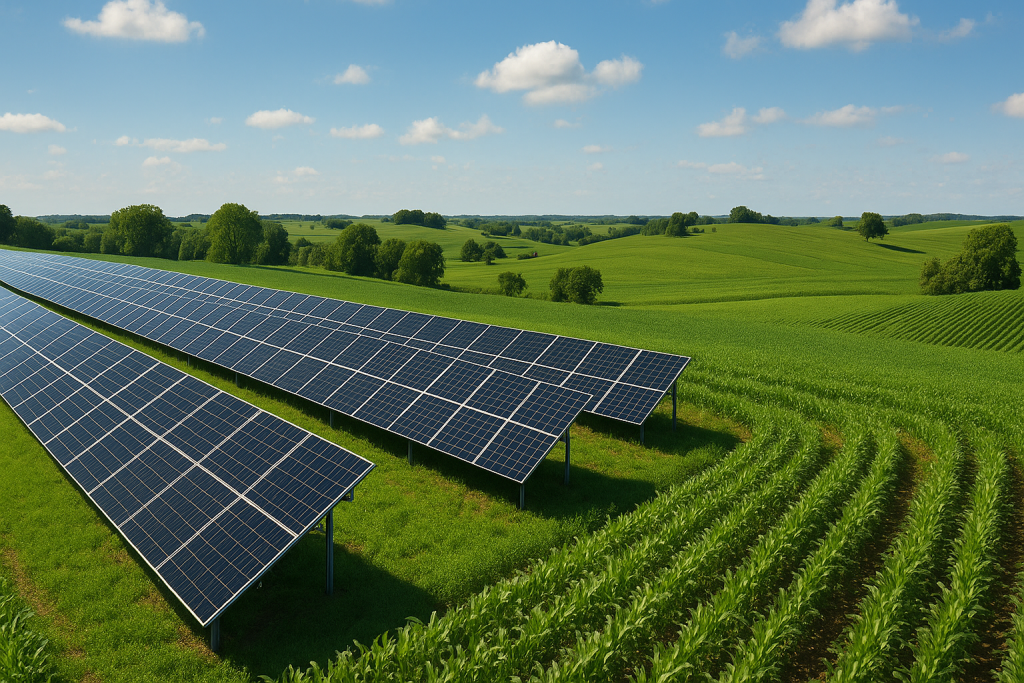 I believe General Mills’ pledge to nurture our planet beyond 150 years—by advancing regenerative agriculture on one million acres by 2030—crystalizes the need for long-term land stewardship (see General Mills Regenerative Agriculture) . Perhaps, it seems, pairing solar energy with farming—known as agrivoltaics—could be the linchpin for protecting dirt that fed our grandparents and will feed our grandkids.
I believe General Mills’ pledge to nurture our planet beyond 150 years—by advancing regenerative agriculture on one million acres by 2030—crystalizes the need for long-term land stewardship (see General Mills Regenerative Agriculture) . Perhaps, it seems, pairing solar energy with farming—known as agrivoltaics—could be the linchpin for protecting dirt that fed our grandparents and will feed our grandkids.
In simple terms: shade. Vegetation blanketing the soil beneath panels cuts raindrop impact and slows runoff. It’s like giving the earth its own umbrella. A recent Penn State study finds that healthy groundcover under solar arrays dramatically tames stormwater flow, preventing gullies from carving through fields on sloped terrain . Short-sighted farming strips that protective layer off topsoil. Big mistake. With solar cover, the roots of native grasses anchor sediment, holding fertile particles in place.
But wait—there’s more. The photovoltaic (PV) racks themselves intercept rainfall, redirecting water gently to the ground below. Researchers report that test plots beneath PV panels experienced 27%–63% less soil detachment than bare-field controls . It’s wild, right? This isn’t just power. It’s power plus protection. Multifunctional land use at its finest.
It makes sense economically, too. If your field’s yield is meh—or if you’re not feeling farming anymore—leasing to a solar developer means steady lease checks. Income stability. No fertilizer runoff fouling creeks. No seasonal erosion gouging gullies. Instead, you get greens in your bank and greener practices on the ground. More critically, you pause chemical inputs long enough for organic matter to build up again. Over time, resting land under panels elevates soil health metrics in ways that simple crop rotation can’t match .
Economists call this “revenue stacking.” The farmer keeps grazing rights or even plants shade-tolerant crops like certain medicinal herbs beneath the racks. And they still collect rent. No gamble on volatile commodity prices. Meanwhile, General Mills and fellow food giants reward regenerative proof points—so farms that measure improved infiltration or carbon content could snag premium contracts.
There are caveats. Groundcover management isn’t trivial. One must seed native species and avoid tilling right up to the steel posts. Proper grading and sediment traps ensure water doesn’t concentrate and carve channels that defeat the purpose . A little elbow grease yields big dividends.
In essence, agrivoltaics offers a 100-year vision—or more—by weaving renewable energy and soil stewardship into one. It’s not just farming or solar. It’s farming plus solar. A dual act where the sun’s rays fuel homes while the soil beneath stays calm, cool, and intact. Farming legacies deserve protection. And thanks to solar panels, those fields can rest and recharge—just like we all should. Imperfect? Sure. Yet, it’s an imperfectly brilliant way to keep Iowa’s farmland flourishing for our grandkids.
